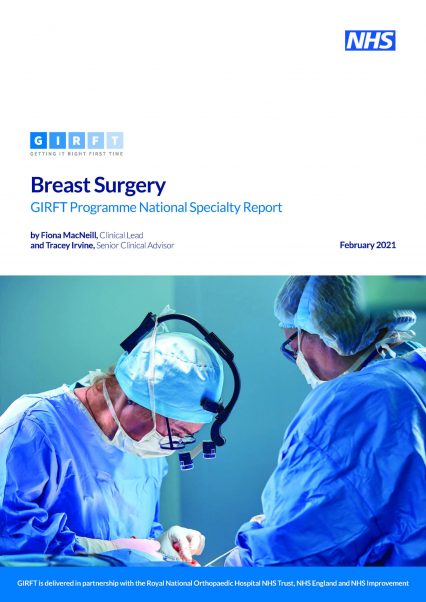Getting It Right First Time (GIRFT) national report for breast surgery – Published online
Posted in Announcements, General news, and Publications.
Back to News
Thank you to the GIRFT team for providing the following comprehensive summary of the breast surgery report:
Measures which will allow clinicians to focus on older patients, who are more likely to have breast cancer, are among the key recommendations in the recently-published GIRFT national report for breast surgery; helping the NHS to restore safe and efficient care post-pandemic.
The GIRFT report – written by Tracey Irvine (consultant oncoplastic breast surgeon at the Royal Surrey County Hospital NHS Foundation Trust) and Fiona MacNeill (consultant breast surgeon at the Royal Marsden NHS Foundation Trust) – is the most complete picture of breast surgery activity there has ever been: the first time data about all breast operations in England has been brought together, whether carried out as plastic surgery, breast surgery, general surgery or another specialty. It focuses on surgery related to breast cancer but also looks at surgery for non-cancer reasons.
It is now available for everyone working in the specialty to download, even if you do not have an NHS email address. Click on the picture of the report to download it (you will need to register for access to this site, but permission is granted quickly).
The report follows meetings with clinicians and managers in 129 breast surgery units.
GIRFT’s deep dive discussions showed that the need to meet the ‘two week wait (2WW)’ access standard is the biggest challenge facing breast surgery teams. There are more than 500,000 new outpatient referrals every year in England and the number is increasing, but cancer detection rates have stayed the same. This is because referrals are rising for younger women, especially those under 40 who are least likely to have cancer, with a smaller increase in referrals among older women, who are more at risk.
One of GIRFT’s core recommendations aims to make referrals more flexible and to standardise assessments, giving patients more control and choice over their tests and treatment while still ensuring services can meet the new 28 Day Faster Diagnosis Standard (FDS).
The ability to manage new referrals is more crucial than ever as services work to maintain the capacity for early diagnosis in a post-COVID system. The pandemic has demonstrated the need for a more nuanced approach which can target those at greater and lesser risk of cancer in different ways and support appropriate breast assessments as efficiently and safely as possible.
Innovations which could help to achieve this include:
- Better breast health awareness information for everyone, especially those with lower risk of cancer, and more targeted breast cancer awareness information for those in higher-risk groups, such as those over 70;
- Piloting new assessment pathways such as ‘straight to mammogram’ for women over 40 who have concerns about breast changes;
- Piloting open access clinics so that patients can choose when to attend.
The report is enriched with patient stories and aligns with the NABCOP principles – at the time of GIRFT’s national review visits only 16% of trusts had a dedicated pathway for the older patient, but this was discussed and explored further at every deep dive meeting.
The authors also address the need to reduce unnecessary visits to hospital, minimise unnecessary interventions and improve data collection to inform future improvements in a post-COVID system.
GIRFT’s data shows around 102,000 breast operations are carried out every year in the NHS in England – 85% performed by breast or general surgeons and 15% by plastic surgeons. More than 60% of admissions are directly related to primary breast cancer treatment.
Recommendations in the report aim to ensure that any woman with breast cancer can make a balanced and informed choice on her treatment, unrestricted by resources. This includes having full access to the latest oncoplastic surgery techniques and neoadjuvant therapies, supporting safe cancer surgery and breast appearance after breast conservation or mastectomy. Careful selection of procedures can help to avoid some mastectomies in all age groups, and help ensure patients do not undergo more surgery than they need, making more effective use of resources for essential care.
GIRFT strongly recommends that oncoplastic multidisciplinary teams (MDTs) are established in all units, both to support more oncoplastic conservation and, for women who opt for mastectomy, to provide access to the full range of reconstruction techniques most appropriate for her needs, regardless of age.
New data in the report on immediate reconstruction rates by age group shows that around half of women under 50 have an immediate reconstruction following mastectomy, compared to under 10% of women over 70. There has been a small increase in the proportion of women over 70 who have an immediate reconstruction in recent years – in an ageing population, with a growing proportion of people having different expectations of what ‘old age’ should be like, it is likely that demand will increase further.
The report also strongly recommends that clinical coding and data capture in the specialty must be improved – including the routine collection of patient reported outcome measures (PROMS) – to provide quality evidence to help understand progress, track the impact of COVID-19 and better plan future care.
Published November 2021
Copyright © 2024 NABCOP | Lovingly Crafted by Mixd

